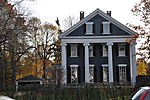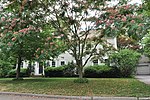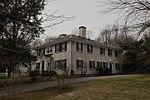Second C. A. Sawyer House
Colonial Revival architecture in MassachusettsHouses completed in 1919Houses on the National Register of Historic Places in Newton, MassachusettsNewton, Massachusetts Registered Historic Place stubs

The Second C. A. Sawyer House is a historic house at 86 Waban Ave. in Newton, Massachusetts. The 2+1⁄2-story brick building was designed by Derby and Robinson and built in 1919. It is a well-executed example of Colonial Revival styling in brick, and demonstrates infill construction in established neighborhoods. It is the second of three houses designed by Derby and Robinson for Charles Adrian Sawyer, a builder, and built between 1910 and 1926.The house was listed on the National Register of Historic Places in 1990 as "C. A. Sawyer House (Second)". The National Register incorrectly lists it at 221 Prince Street.
Excerpt from the Wikipedia article Second C. A. Sawyer House (License: CC BY-SA 3.0, Authors, Images).Second C. A. Sawyer House
Waban Avenue, Newton Waban
Geographical coordinates (GPS) Address Nearby Places Show on map
Geographical coordinates (GPS)
| Latitude | Longitude |
|---|---|
| N 42.324444444444 ° | E -71.234722222222 ° |
Address
Waban Avenue 86
02468 Newton, Waban
Massachusetts, United States
Open on Google Maps










